#vienna post war modern
Explore tagged Tumblr posts
Photo





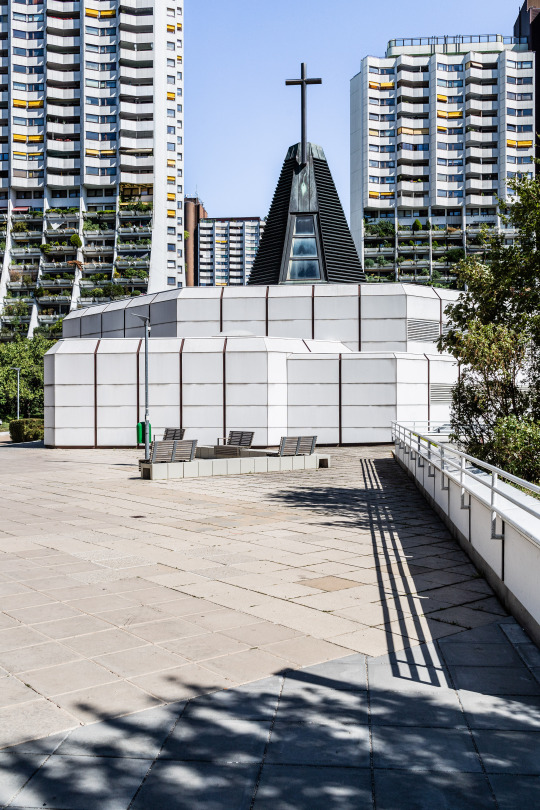




wohnpark alterlaa // wien liesing
II
this post and the next one are about views in and through the alterlaa complex. the site is not flat as one might think from aerial views but consists of several levels in the path structure. the parks are also slightly hilly and winding, which always makes for exciting views and insights.
construction time: 1973-1985
architects: harry glück, requat & reinthaller & partner
#moderne#alterlaa#wien alterlaa#vienna#wien liesing#austria#architecture#photography#urban#urban photography#architecture photography#post war modern#post war architecture#vienna post war architecture#austrian post war architecture#vienna post war modern#nachkriegsarchitektur#nachkriegsmoderne#nachkriegsarchitektur wien#nachkriegsarchitektur österreich#nachkriegsmoderne österreich#brutalism#apartment block#high rise#harry glück#requat & reinthaller & partner
150 notes
·
View notes
Text

Enrico Pacella for Horizont Kollektiv:
Swiss Brutalism inspired backdrop & logo for promotional posters for Horizont Kollektivs (Vienna) first collection of various writings titled
"Horizont Gesammelte Schriften Band I"
#enrico pacella#horizont kollektiv#vienna#brutalism#swiss brutalism#xerox#xerox art#industrial art#post modern#post industrial#structuralism#bookbinding#art nouveau#jugendstil#contemporary art#accellerationism#occultism#ink art#architecture#post war
1 note
·
View note
Text
The Second Blade: Diplata - Extinct Bolo
Continuing the countdown to the launch of the Gubat Banwa Kickstarter coming up on the 10th of October- 6 days to go! Gubat Banwa is a tactical war-drama TTRPG set in the Sword Isles, a fantasy setting inspired by Southeast Asian cultures and folklore.
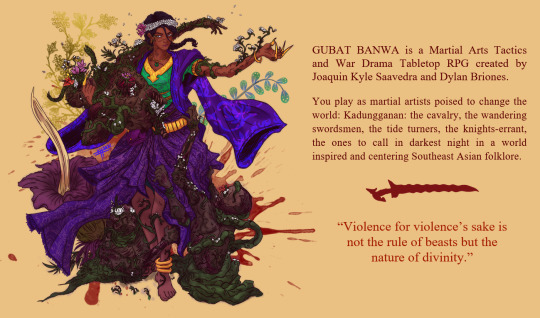
To promote its launch, I'll be posting some of the weapons I've been drawing for the game every day until the campaign kicks off in earnest. These were meant to be Swordtember entries, pardon the lateness I suppose. 2/7 blades so far, let me introduce you to the DIPLATA.

The diplata is a short-to-mid-length blade with a distinct handle, with most specimens sporting a horn-like protrusion facing the same side as the edge.

The blade shape itself I feel is something common across most toolblades in the Philippines, not much longer than one's forearm with a more-or-less rounded out tip- though the diplata seems a bit wider than most. I would say the most unique features definitely lie in the shape of the hilt, and the circular guard. Most Philippine blades don't have anything in the form of hand protection, so a wide guard like this stands out.

This one was a little difficult to find photo references for, as apparently they're quite rare. Some blade scholars call it an "extinct" blade, meaning those who traditionally forge authentic ones supposedly aren't around anymore.
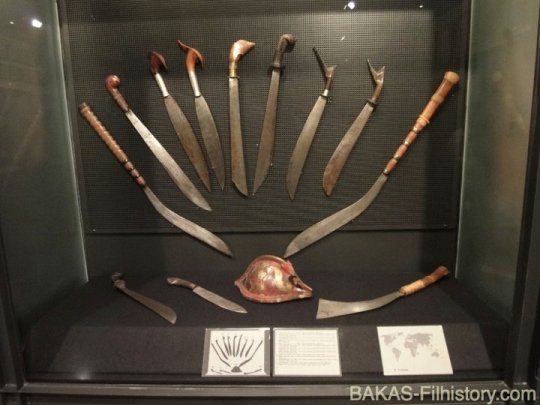
(Photo from Victor Balaguer's museum near Barcelona; Diplata on the blades hanging on the wall, the two next to the rightmost blade) "Traditional" blades refer to those made by the same people to whose culture a blade belongs. To illustrate in the simplest terms, a katana made by a traditional Japanese swordsmith would count as a traditional blade. A messer made by a traditional German blacksmith would count as a traditional blade. I'm sure there's more internal nuance there, but that's the quickest reference point I could come up with. Take note however that the Philippines is composed of many, many different cultures who all happen to exist in the same archipelago with varying levels of overlap- there is no singular, unifying blade culture, so categorizations like "Traditional" and "Modern" (often referring to modern reproductions) aren't always as exact as convenience may demand. In particular, material exchange between cultures makes a mess of this categorization, not just because the blades themselves could get traded (or stolen or lost) and physically make their way to other places beyond the imaginary borders of their "homelands", but because the smiths themselves (or their knowledge and techniques) may travel around. Smiths in different places may also see blades from different cultures that they might feel like imitating or emulating in some way- that's how certain Philippine blades obtained D-guards- but that's a story for another time. The diplata is oft-attributed to the Aeta peoples, specifically those who come from Mt. Pinatubo in Zambales. Not much confusion as to whose culture these blades belong.
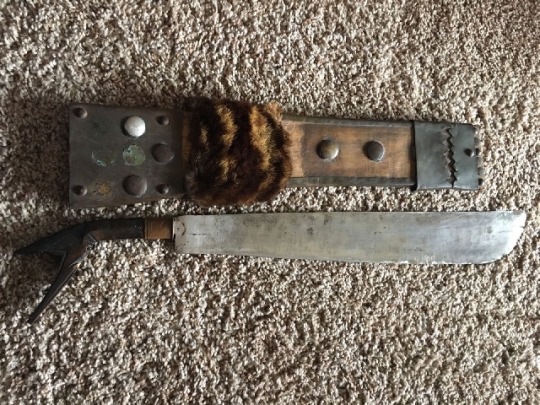
It is a little disheartening that most of the refs I could find were photos from foreign museums and loose images in books and blade forums. I will not speculate here as to how these blades ended up in these places, but it isn't hard to guess.

(Image from a Spanish museum)

(Image from Philippines, Early Collections, Museum of Ethnologie Vienna)

(Image from The Philippine Journal of Science Volume 81) I'm not a hardcore blade scholar, but even I recognize how inseparable blades are from the myriad cultures of the Philippines. I'm forever thankful to the random communities of blade enthusiasts who dedicate a not-insignificant portion of their time (and wallets) to supporting local artisan blacksmiths to grow their collections, and keeping track and tracing which blades came from which places and peoples. Our blade cultures are alive and still developing, but they could still use a little help sometimes, just so we don't lose them.

(Photo from the collection of Zel Umali) In any case- while it's not exactly a scholarly work in the academic sense- part of Gubat Banwa's violence is pushing a fantasy setting of our own making, as seen by our own eyes, as told on our own terms. This is no foreign museum; This time, SEAsian cultures take center stage.
The Gubat Banwa Kickstarter launches in 6 days! Check it out here:
It would be a huge help to this very small team from the global south if you could help us get the word out! We straight up can't afford to advertise on the same scale as bigger players in the field, so we're relying heavily on word of mouth. You can find out more about the game on its itch page.
#gubat banwa#gamedev#ttrpg#ttrpgs#indie ttrpg#indie ttrpgs#tabletop rpgs#rpgs#rpg#southeast asia#southeastasia#dnd#kickstarter#swords#philippine blade#weapon design#dagger#philippine history#philippine culture#filipino artists#artists on tumblr#kathang langit#help us get the word out!#fantasy#fantasy worldbuilding#swordtember#bolo#itak#diplata
101 notes
·
View notes
Text

the encounter
➝ a painting, an agent and a crime. sounds good, no?
➝ word count: 3,9k
➝ warnings: descriptions of crimes, reader being clumsy
➝ author’s note: i finally felt safe enough to post this story. it's a more or less alternative universe, since it has some real things (i'd love to know your bets). hope you like it.
It was an ugly, gloomy day in Vienna, and you found yourself sitting in the cafe you tended to frequent these days. As far as anybody knew, and as far as you told anybody, it was a nice place to come and work during the day, so almost every day for the past few weeks, you sat in your usual seat by the window and sipped coffee as you ostensibly worked on something important on your laptop. As far as anybody asked, the cafe was comfortable enough and it was fairly close to your apartment, and you simply weren’t quite as productive when you were working at home. That’s what you told people, along with the fact that you worked in finance.
You weren’t working on anything at the moment, because your mind was elsewhere, and your eyes were fixed on something across the street from the cafe. You were staring at an old antique shop, with a dark green facade and gold lettering across its front window. You were watching the people inside, talking animatedly, trying to imagine what they were speaking about.
— Maria — you heard someone say. The name was familiar, after all, that was the name that was listed in the identity documents that your boss handed to you in a manila envelope a few weeks earlier, along with an investigation report. Hearing the name brought you back to when he was briefing you on the operation, which had been named “Królowa”, a reference to the object of the investigation. You had been assigned to search for information on a triptych painted by the Polish master painter, Jan Matejko, that depicted a procession accompanying the Virgin Mary and the Baby Jesus to a cathedral in Kraków.
The triptych was considered a lost Polish national treasure, stolen from its most recent owner during the Nazi occupation. Previous investigations into its whereabouts dragged on for years, buried in the files of the Europol, based in The Hague, in the Netherlands. When you started working there, almost a decade earlier, the case was stuck on a cold lead about the piece's last owner, Count Hieronim Tarnowski, a Polish aristocrat.
The last documented whereabouts of the triptych was within Montelupi Palace in Kraków, which was owned by the Tarnowski family. However, the palace and all of its contents were expropriated by Nazi command in 1942, before the interior of the Palace was consumed by fire. From then on, there was nothing further documented about the of the painting. It and some other cultural treasures seized by the Nazis were long considered lost by the Polish government and Europol. That is, until one day, you found something that made you dig deeper into the case.
You were doing some research for another art theft case when you found an open thread about Matejko on an art forum. While you were reading praise for the painter's work, you came across a photo posted by a user called Piter1974 that caught your attention.
It was a photo of the triptych, clearly taken with a modern camera given the quality and colors of the image. They contrasted sharply with the images attached to the investigation that you had as reference, which had been taken from pre-war catalogs. The only existing photos of the work were all in black-and-white, taken with early 20th century cameras. You did some cursory checking on the authenticity of the image, and didn't hesitate to print it out. You placed it on your boss’ desk with an air of confidence.
— What is that? — your boss, a burly, perpetually grumpy Frenchman named Romeo, asked.
— It’s Matejko’s triptych.
He looked unconvinced as he cocked an eyebrow.
— Came to show me your Photoshop skills? The colors look nice, but…
— I didn't color this photo.
Romeo blinked.
— Do you mean…
— It's a recent image — you said, proudly — The EXIF data shows that it was taken on October 6, 2022.
— Where did you find this?
— On an internet forum. A user posted this in a discussion thread about Jan Matejko's works.
— You…
— It’s not AI or Photoshop. I checked, Romeo — you replied, smiling — The triptych still exists!
Your discovery led to the case being reopened, with the image being examined pixel-by-pixel for any inconsistencies, and your findings being verified. The EXIF data buried in the picture not only showed the date, but it showed what kind of camera the image had been taken by, which was a high-end professional model popular with archivists and museum curators for taking high-quality images suitable for cataloging.
You felt frustration wash over you. The trail seemed to have gone cold again, after all, how many art galleries were there in the world? It was like you were looking for a needle in a haystack.
But again, fortune smiled on you. While analyzing an old catalog of Jan Matejko's works written by a Polish author, you came across new information about the triptych's whereabouts. According to the catalog’s author, after being confiscated by the Nazis, the triptych briefly reappeared in the 1960s, in the inventory of a well-known antiques shop in central Vienna. Your relief was short-lived when you saw the name of the shop’s owner.
“Of course Bednarczyk is involved in this”, you thought to yourself, letting out a long sigh.
Czesław Bednarczyk was an old acquaintance of the Polish justice system. He had been a notorious smuggler, taking vast amounts of Poland’s cultural treasures and gold abroad, most of it to be sold in his antique shop in central Vienna, on the Dorotheergasse.
Despite the mountain of evidence against him, the antiquarian never faced justice for his crimes, nor did his reputation within the art world suffer. When he died in the late 90s, the funeral was attended by great figures from the industry, all paying their respects to the patriarch's family, who worked to preserve his legacy to this very day.
Bednarczyk's antique shop was taken over by his eldest daughter, Elisabeth. She was known for being one of the leading experts on Viennese porcelain, which kept her from being a major suspect. However, you thought, that didn't mean the place couldn't be involved in some way, as other Matejko pieces had been sold by the Bednarczyks over the years. And so, you went to Vienna with a false identity and a single objective: find the triptych.
After arriving in the city and settling into the apartment that would be your base, you tried to investigate the surroundings of Dorotheergasse, the narrow lane where the antique shop was located. In short order, you found the perfect place to monitor movements in and out of the shop without raising any suspicion — a cafe next to the Jewish Museum across the street. — Maria — the voice repeated, making you wake up from your thoughts. You glanced over your shoulder, finding the friendly smile of Kristina, the cafe's barista — Is everything okay?
— Yes, everything’s fine — you replied quickly, fumbling to hide the fact that you had forgotten that was the name you’d given to the waitress — Why?
— Oh, you… Called me over to place your order, but when I asked you what you wanted, you didn't say anything...
You felt your own cheeks heat up.
— Sorry, Kristina, I was distracted…
— By the antique shop?
You were apparently being too obvious. You wished the ground would swallow you whole.
— Well, no… Not exactly…
— Oh, I’m not surprised. — Kristina laughed — When you said you had just moved to an apartment nearby, I sort of figured you had an eye for art and antiques.
— But, how?
The barista chuckled.
— I mean, you’ve seen the kind of people that come in here. It’s only old people or people that are crazy about art, and you’re obviously not old.
You smiled, trying to hide your discomfort at feeling so transparent.
— I do like art — you lied — My parents had a lot of pieces at home, like sculptures, porcelain...
— Oh, that shop has a ton of those things.
You raised your eyebrow.
— Have you ever been inside?
— Yes. I got curious about it and went after work one day.
— Did you talk to anyone there?
Kristina was clearly taken aback by your interest.
— Oh, yes, I talked to a man, he…
— Alexander? — you asked, taking a few seconds to realize that, in your eagerness to find out more about the Bednarczyks, you were close to showing your hand.
— No, his name was something else — she replied, with suspicion on her face — Who’s Alexander?
In truth, you knew that Elisabeth had a son named Alexander. According to the case’s dossier, he was a specialist in contemporary art and responsible for numerous sales of works to foreign galleries and museums. If the triptych had left the antique shop heading abroad, it likely would have passed through Alexander's hands.
— Well, like I said, my parents like art and I remembered they bought a few pieces from a shop in Vienna run by a man named Alexander — you said, trying to cover your tracks — I thought it could be him, but I think it's unlikely, come to think of it. After all, how many art and antique shops are in a city this size, right?
After staring at you for a few seconds, Kristina smiled.
— Unlikely, maybe, but not impossible. I imagine the art world isn’t a very big one, after all.
You went back to focusing on the antique shop. You had noticed some movement near the door and you were trying to pay attention to whoever was leaving, when Kristina cleared her throat.
— Yeah? — you muttered.
— Do you still want something?
Looking at the table, you noticed that your espresso cup was empty, as was the plate full of crumbs from the chocolate cake you had devoured after lunch.
— I think another espresso — you replied. With a nod Kristina walked away from your table, while you looked again at the door of the antique shop as two blonde women came out of the shop’s door. Both of them were talking animatedly and had boxes in their hands.
Just then, you’d decided you’d spent enough time over the past few weeks watching and waiting — you had to see what was inside.
The next day, the plan was already drawn up in your head. You would go into another antique shop in a different part of Vienna and buy something made of porcelain, something that seemed to be antique. And then, you would go into the Bednarczyk’s shop to try and have it appraised. It belonged to your mother, you would tell them, and you wanted to find out what they could tell you about it and see if it could be restored. Anything to buy more time.
You’d let the staff at the shop talk to you, you knew what questions to ask to not seem like you knew nothing about the pieces, but what to avoid asking to not show that you knew too much. While you were talking to them, whoever they were, you would try to work in a way to ask about any Matejko pieces they knew of.
Your plan was hastily arranged, but it seemed like it should be perfect.
You found another antique shop in Ottakring, across the city, and bought the first porcelain piece you spotted that you knew was old enough to seem like a treasured family heirloom. You thought it would be a good idea to stop by the cafe first and have an espresso to settle your nerves before heading into Bednarczyk’s.
You walked down the street to the direction of the antique store with the box containing the little sculpture in your hands, confident this would be a big step forward in the investigation of the tryptich’s whereabouts.
As you were glancing toward the shop’s entryway, you let your attention slip for a moment, crashing into the back of the man who was walking ahead of you. The box in your hand slipped and fell toward the ground, the muffled tinkling of shattering porcelain coming from inside the box. You immediately sank to the ground and lifted the flaps on the top of the box.
— No, no, no, fuck — you said, seeing the ballerina you bought reduced to a pile of shards.
— Shit — the man said from above you. When you looked up, you realized that you had stumbled into a man with dark hair and brown eyes, who were fixed on what was once a small porcelain statue — I'm sorry, I didn't see you coming in behind me…
— No, it's okay — you murmured, trying to hide your displeasure at having broken the piece. You had chosen the porcelain ballerina precisely because you knew that it was old enough to be of interest to Elisabeth. However, you couldn’t exactly get her to appraise a pile of dust — Isn’t a big deal...
— From your reaction, it seemed like something important — the man said, as you closed the box quickly and stood up — I’m so sorry. I hope it wasn’t a family heirloom.
You looked up at him, pressing your lips together as you realized how tall he was. “Focus… Maria”, you thought to yourself, feeling your face heat up. You couldn't let your cover identity slip.
— Yeah, it was. I had brought it to see if there was somewhere that could appraise it, maybe restore it, but… I don’t think there’s much to be done about it now.
Looking at the box, the man seemed to think for a few seconds, before looking up at you again.
— Well, if you want, I can find something else to give you instead. I’ll pay for it.
— I don’t…
— That won't replace the sentimental value, no, but it's the least I can do, considering your little ballerina is broken because of me.
You hesitated for a few seconds. You didn’t want to involve another person in your investigation, especially an innocent bystander that made you feel a strange heat in your chest and a strange flush in your cheeks. However, before you realized it, you were following him down the street, the box with the porcelain shards in your hands, into the front door of the Bednarczyks' antique shop.
He opened the door and motioned politely for you to walk in first, which you did, unable to hide the shy smile on your face. The man closed the door behind him as you approached one of the shelves. It was stocked with a huge assortment of miscellaneous knicknacks - silver candelabras, ceramic vases, sets of different glasses and jars, all polished and carefully arranged. Your eyes landed on a velvet box on one of the middle shelves, and you couldn’t resist the compulsion to step forward and carefully tilt open the lid, trying to see what was inside.
— It's a set of silver flatware — a female voice said behind you. You turned around with a start to see a short, blonde woman with kind brown eyes staring at you. She smiled — Sorry, I didn't mean to scare you. Mr. Wolff asked me to come assist you.
— Mr. Wolff? — you asked, confused.
— The gentleman who came in with you.
You were still confused, wondering how she knew the other customer’s name.
— By any chance — you started, stopping when you felt someone touch you shoulder.
— Ah, you found Petra, excellent — the man, apparently Mr. Wolff, said — Petra, could you show us the porcelain?
The woman nodded and directed you to another set of shelves, chatting about , the woman guided you between the shelves, chatting about the store's new arrivals. However, your mind was occupied with trying to remember if you’d ever seen the name Wolff anywhere in the case files. The man seemed to be too familiar with the staff to be just another customer. You remembered reading about Elisabeth, her son, Alexander, and Alexander’s wife, Amy. However, you didn't remember any man with the surname Wolff.
— Here is our selection of porcelain. I'll leave you to choose what you would like — Petra said, with a smile.
— Thank you very much, Petra. As soon as we choose, we will call you.
With a nod, Petra walked away, leaving the two of you alone in front of the shelves filled with figurines, cups, teapots and porcelain vases. After a few seconds of silence, you finally looked at the man next to you.
— Mr. Wolff, is it? — you asked, the tone of your voice causing a smile to appear on his lips.
— Well, yes. Torger Wolff. But you can call me Toto.
Something about what he said made you smile.
— Toto, like the dog in The Wizard of Oz?
— I would say like Toto Rina, the Italian mafioso, but most people think of the dog first — Toto said, without taking his eyes off you — And you, what's your name?
You hesitated for a few seconds.
— Maria.
— Just Maria?
— Maria Bauer.
Toto chuckled.
— Ah, a fairly common name, no? — he asked. “It had to be something from the idiots in the operations department”, you thought to yourself, giving a wry smile.
— My parents weren’t the most creative…
— In my case, they were too creative — he said, looking at the shelf again — I suppose you’re not not from Vienna?
His question made you swallow hard.
— No, I'm not. I moved here not long ago. How did you know?
— Your accent — Toto replied — I'd say you're from the south, maybe. Graz?
— Klagenfurt — you said. That’s what was in your identity document. You hoped he wasn't familiar with the accent there, since you were sure that the Dutch and English you were used to speaking on a daily basis with your co-workers was present in the way you slurred some syllables.
— But you've lived abroad, haven't you?
— Why do you ask?
— Your accent doesn’t sound like a Southern accent. I have an acquaintance from near there, but his accent is a bit different.
— My mother is Dutch — you lied, almost in an attempt to stop that interrogation — So, I grew up listening to her accent and ended up picking it up.
— Ah, yes, I understand — he said, giving a gentle smile.
Turning your attention to the shelf, you tried to focus on the china in front of you, trying to decide which piece would be the most similar to the one he had broken. Not that it mattered much, but one did catch your eye. It was a figure of two people - a man and a woman, sitting next to a column, with the woman holding a rose and the man holding a basket of flowers on his lap. It was romantic, and oddly endearing.— Did you like this one? — Toto asked.
— Yeah — you replied, your fingers brushing the top of the porcelain column, where there was a small hole to hold a few flowers — It's very beautiful.
— I agree.
— With such a renowned expert curating the collection, it's not surprising — you said, taking the porcelain figure in your hands.
— Oh, do you know of Elisabeth? — he asked. You glanced over to Toto to find that he had a curious expression, like something you said made an impression.
Maybe you’d already said too much.
You’d betrayed the fact that you were not from Vienna and had recently moved to the city, leaving you no acceptable excuse to explain how you knew who owned the shop you were in. It wasn’t as if she was well-known outside of very specific Viennese society and academic circles — No, I don't know her — you said, giggling nervously.
— So how do you know she curates the porcelains here?
— Well, like I said, I recently moved and I'm still cleaning up my apartment, so I'm working from the cafe across the street — you lied, trying to sound as calm as possible — And, one day, I noticed the antique shop across the street and looked up some information about it online. My parents collect art - mostly these porcelain figures, so I thought I’d bring in one of their older pieces to have it appraised and restored, since she seemed like the best person to do it.
— Of course, the internet — he said, laughing — What's not on the internet nowadays, right?
— Right? You can find anything — you smiled, feeling your heart pounding. He seemed to buy it, but you couldn’t guarantee that you’d be so lucky next time.
After asking if you liked the piece you were holding and calling Petra to confirm your choice, Toto asked you to stay there, before heading towards the counter at the back of the shop together with Petra.
Watching him talk to Petra, you started feeling guilty. You had only just met Toto and you already felt terrible about lying to him, which made you feel even worse, as feeling such strong emotions about telling lies was an occupational liability for you. But still, he had nothing to do with the investigation beyond knowing who Elisabeth was, and ostensibly frequenting her family’s antique shop. He certainly wasn’t a person of interest, so you could only conclude that he was one of her wealthy patrons. “He must be rich”, you thought, watching him scribble something on a piece of paper and hand it to Petra.
Perhaps, in other circumstances, you could get to know each other better. It was crazy, you thought, to be imagining a future with a man you knew nothing about and had just met mere moments ago, but you couldn’t help it as you looked at the way he smiled at you. It was a sweet, warm smile, and you’d never met anyone else you felt a connection with so immediately. It was the same smile he gave you once more as he handed you an elegant box that Petra had given him. “What a handsome son of a bitch”, you thought, giving him a small smile.
— Here — Toto said, handing you the box — I know it's not a one-for-one replacement, but it's my way of apologizing for the accident earlier.
— It’s no problem, really. You could very well have ignored what happened and kept walking, so…
— No, I don’t think that would have been — he murmured, eyes fixed on yours. That intensity of his gaze on you made your own cheeks feel hot.
— What do you mean by that? — you asked, giggling nervously.
— It would be impossible to ignore you — Toto said, seeming to realize the effect of his own words on you — I could never just walk past you.
The room filled with silence that stretched out long enough for you to think of a million scenarios in which you would end up with your lips pressed against his.
— Well, I'm going to take this home — you finally said, taking a brief look at the box — Thank you for your kindness, Toto.
— It was the least I could do, Maria — he replied with a smile, putting a peculiar emphasis on your name.
Giving one last wave, you turned around and left the antique shop feeling like you were floating. However, nothing compared to the feeling that came over you when you opened the box and found a note on the bubble wrap that surrounded the delicate piece of porcelain.
— I'd love to see how it looks on your shelf — you read quietly, realizing that Toto had written his phone number below his message while Petra was wrapping the figurine.
You dug into your purse and pulled out your phone, but started feeling guilty again. You were in Vienna for work, not to flirt with strangers. You were dealing with dangerous people and getting involved with more people meant additional risk, not only for them, but for you and your career.
“Well… one photo of my bookshelf probably won’t hurt anyone”, you thought, before saving the number on your cell phone.
#toto wolff#wlffog#formula 1 fic#f1 fic#f1 fanfic#formula 1 fanfic#formula 1 x reader#toto wolff x reader#f1 x reader#formula 1 x you#toto wolff fanfic#toto wolff fluff#formula one fanfic#formula one fic#ocwlff
67 notes
·
View notes
Text
2024 Book Review #21 – Danubia by Simon Winder
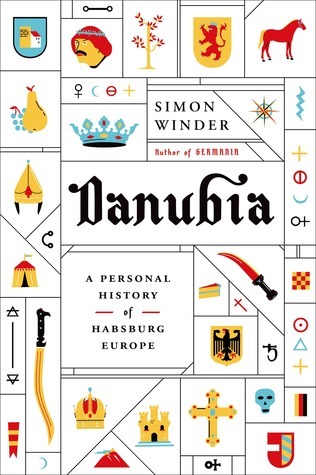
I picked this up because I’ve been trying to read one history book a month, and I happened to scroll past a viral tumblr post with a quote from its introduction as I was figuring out which book that would be for April. Helpfully, there was no one ahead of me waiting for it in the library. A one-paragraph quotation and the book’s cover aside, I went it basically entirely blind. The book took a bit of adjusting to.
The book is a history of Central Europe through the lens of the Habsburg Dynasty, and it is a history of the Habsburg Dynasty through Winder’s extensive travelogue visiting every historical city and museum exhibit in the Danube basin. A roughly chronological sequence of events is followed (common and sometimes extensive tangents and diversions notwithstanding), but nearly every new section is introduced with an anecdote of visiting some town, castle or church that was relevant to the events about to be discussed, and a contemplation of its aesthetic significance to the modern traveller.
Meandering aside, the book does a good job of covering the broad sweep of a millennium of history and hits all the high points you expect it to (Charles V, Rudolph’s Prague, the 30 Years War, 1848, 1866, 1914, etc). The basic dynastic and political history is broken up and intermixed with a surprising amount of time dedicated to the cultural products of each era, which one does very much get the sense are what really fascinates Winder. The painters, composers and architects features get space that’s determined less by their general modern fame or contemporary significance and more because they happened to capture the author’s interest. I certainly came out of this with far more opinions about Vienna’s classical music output across the ages than I expected.
Winder’s voice is strong to the point of overpowering throughout. Which is quite deliberate I’m sure – this is a breezy read full of cute trivia, not a monograph – but even still, it sometimes gets a bit much. Instead of an academic lecture the effect is similar to listening to a guy whose perhaps not quite as insightful or interesting as he thinks he is hold forth over drinks in what only barely qualifies as a conversation. The effect is usually quite charming! But it does wear on you. It also makes getting particularly caught up on the precise accuracy of every bit of trivia feel kind of beside the point.
Winder is also a middle-class guy from southern England, which I might feel bad about saying ‘and you can tell’ if he didn’t bring it up himself quite so much. Anyway, knowing this makes the whole pitch of the book as ‘a walk through the age and region where all the slaving and massacres and depopulation and brutality we associate with Over There happened in Europe too” make so incredibly more sense. Even if it perhaps still shows an ever-so-slightly naive view of what preodern history also looked like in Western Europe.
Still, a significant portion of the book is dedicated to the sheer brutality of early modern religious warfare, both between the Ottomans and various Christian princes and coalitions, and between different sects of Christians. Winder thankfully has no taste at all for grand battles or heroic violence, and devotes as little wordcount to the various epoch-defining wars as he can get away with. He’s more interested in the consequences of them, the brutal and brutalizing violence that led to the depopulation and resettlement of what became the Hapsburg empire several times over across its history.
Which leads into the book’s other main theme. Winder is very much not a fan of nationalism, especially of the kind that made the region’s 20th century such an apocalypse. The book views it as an absurd horror in general, and even moreso in a region where every city and ‘national homeland’ was hopelessly intermixed, and every land continually resettled. The last chapters make the point that the ‘nationality’ of much of the population was, if not arbitrary, then certainly contingent, with massive amounts of assimiliation across national and ethnic lines happening quite late into the 19th century (and before that, historical nationality being more happenstance of language and religion that any primordial cultural essence). It is only as the Habsburg’s legitimizing mythology fell apart that nationalism became the only vital organizing force in the empire, and the grounds on which battle lines were drawn and spoils competed over.
The book does portray the whole latter 19th century as a dialectic between increasingly absurd and ineffectual but (and so) increasingly benign Hapsburg rule to the rising and inevitably exclusionary and vicious nationalisms that would tear it apart. The closest thing to the political left that makes a sustained appearance is Napoleon. Which is somewhat excusable in terms of what the post-Habsburg political situation did end up looking like, I suppose, but given the size and significance of the SDAPO it’s a bit of a gap. One more way the author shines through, I suppose.
The tragic epilogue is of course that Europe now is full of (more-or-less, if you squint) neat and semi-homogenus nation-states. Not because of any peaceful triumph of liberal nationalism and self-determination, but rather one outburst after another of apocalyptic violence, of emptied cities and gore-soaked fields. The book was written before both the current invasion of Ukraine and the most recent war in Gaza, but had either been ongoing they probably would have gotten referenced as further examples of the bloody logic of nation-building (Winder have basically categorized Zionism as the Jewish iteration of the general outburst of homeland-conquering nationalisms in later Austria-Hungary, with the Palestinians in the same unfortunate position as the inconveniently-non-Romanian Magyars in Transylvania.)
Anyway, overall a fairly charming read, and Winder’s steadfast belief that the only real justification for the Habsburg Dynasty is all the weird art they paid for is very endearing. But more entertaining than enlightening, I suppose? And if I hadn’t read it in small daily chunks Winder’s voice would have worn on me until I wanted to reach through the pages and pour a drink on him halfway through the second tangent about his family vacation in Paris.
25 notes
·
View notes
Text
Introductions, PSA's, Other Blogs,and Posts Lists.
Hi! I'm Hopster, and welcome to my blog! this is just where i post most of my chaos, which just so happens to be Napoleonic stuff right now.
PSA's
These past few days I have been flooded with asks asking about monetary help for medication, war aid, etc. I have gotten three today alone, and it’s not even 2pm for me.
I want my ask box open for folks, but it’s tempting to close it because of this. I don’t want modern politics on my blog, nor do I have the money to help. So please stop.
That being said, if your ask has anything regarding the asking of money or modern politics (2000-present) it will automatically be deleted and you will be blocked.
And just in case someone wants to start calling me things I’m not, I just want to keep modern politics off my blog. I am surrounded by that shit every day, especially with my situation. This is my safe space where I talk about silly and historical stuff.
----------------
If you are searching for something on my blog: the main for of organization on here is by name, contents, era- and if its in a project of mine- project name.
for example, if you are looking for Napoleon, search napoleon bonaparte. if you are looking for art of napoleon, then it will fall under napoleon bonaparte and art. if youare looking for artwork of Napoleon that is in my From the archives project, then It will fall under Napoleon Bonaparte, Art, and DK archive project.
if it isn't there, then i either haven't reblogged it, or it hasnt been tagged yet.
Other blogs
@trauma-and-truffles
@otdhistoricalbirthdays
@hoppity-hopster-extra
Post List (updated 3-2-25)
Collections
On This Day: Vienna Congress Edition Masterlist
From the Archives Masterlist
Asks
Napoleon et Larrey Image collection
Miscellaneous
Duroc in Copenhagen
Rambling about the Medicinsk Museion and museum newsletters
A Napoleonic Medical History Goldmine.
Record player rambling
Teenage abandonment issues (more rambling)
Ancestry stuff
Ancestry stuff round two: the Disappearing uncle
Pearl Harbor
3D printer fun
I morgen Bliver Bedre Graphic novels
Josephine's Jewelry in the Danish Royal Property Trust
Stuff about Larrey and Bessieres.
Pretty Napleonic Medical men
Larrey art (source unknown)
Larrey Art II (source unknown)
Larrey Stamp
Larrey statue
Larrey art III (source unknown)
Larrey art IV (source unknown)
Details in the Painting "Battle of Moscow" by Lejeune
Surgery meme made by me
Marbot the Cat (and His Near Death Experience)
The Marshals Baton at the Danish War Museum (Tøjhusmuseet)
The Marshals and their Genetics
My first trip to the Ny Carlsberg Glyptotek
Some Benefits to the Napoleon (2023) Movie
The H&M Hussar outfit
The Bust of Metternich
the Ney image
The Mexican Napoleon meme
the Napoleon House in Lerapetra
Larrey on Seasickness (not my og post, but i write quite a bit here.)
My first visit to the Thorvaldsens Museum
Napoleon Spotify playlist
Larrey and his Family (also not my post, I just write a lot here.)
an older Larrey
The Larrey Propaganda
my 3D Printed Napoleon
Davout Cat meme
Bird Identification
April fools day in the Napoleonic bubble
On Yvan
Caroline Seufert rambling
Frederiksberg Gardens II
On Frederik VI's height
Facts about Frederick VI that live rent free in my head
Frederik vs. Frederik
On Frederiks Childhood
On Frederick VI's chair and being able to find a historical figures things.
9 notes
·
View notes
Photo

Frans Geffels - Siege of Buda in 1686 -
oil on canvas,
Hungarian National Museum, Budapest, Hungary
The siege of Buda (1686) (Hungarian: Buda visszafoglalása, lit. 'Recapture of Buda') was fought between the Holy League and the Ottoman Empire, as part of the follow-up campaign in Hungary after the Battle of Vienna. The Holy League retook Buda (modern day Budapest) after 78 days, ending almost 150 years of Ottoman rule.
Buda had been under Ottoman rule for a century and a half, and Ottoman rule had not ended by an uprising of the Hungarians themselves, but by the forceful intervention of the Habsburgs. This fact was reflected in the post-war arrangements.
As a consequence of the recapture of Buda from the Turks, as well as the victory in the Battle of Mohács (1687), the Hungarian parliament recognized at Pressburg in November 1687 that the inheritance of the Hungarian crown had passed to the Habsburgs, without the right to object as well as resist. In addition, the Hungarian parliament committed itself to crown the Habsburg successor to the throne still during his father's lifetime as king of Hungary. Thus on 9 December 1687 Joseph, the nine-year-old son of emperor Leopold, was crowned as a first hereditary king with the Stephanskrone crown. Hungary was a hereditary country of the Habsburgs and already in June 1688 the "commission for the mechanism of the Kingdom of Hungary" was now finally created, in order to create in the country of the Stephanskrone a strong monarchistic government.
Frans Geffels, known in Italy as Francesco Geffels (25 August 1624 – 18 February 1694) was a Flemish painter, printmaker, architect, stage designer and designer of ephemeral structures for solemn and festive occasions. After training in his native Antwerp, he was mainly active in Mantua, where he was prefetto delle fabbriche to the Duke, a role that gave him the direction of the artistic and construction activities undertaken by the Ducal court. He worked also on projects for the local aristocratic class of Mantua. In addition, he completed projects for the Liechtenstein princes and for the imperial court in Vienna.
He was both a canvas and fresco painter. He created portraits, history subjects, military scenes, architectural scenes and genre art, in particular merry companies. Geffels is mainly remembered as the designer of some of the key examples of Baroque architecture in Mantua.
17 notes
·
View notes
Text
@stuffedeggplants Replied to your post:
Yesss thank you for noticing the Navy guy being out of step
haha
it’s the terminal drum corps disease 😔
and the centurion thing that didn't make sense! Regarding the bullet hole in the jacket, my friends and relatives who have been in the military are *really* tuned to notice uniform details, so I don't have a problem believing the Nazis noticed the hole in the jacket and immediately became suspicious.
The way they say Longinus in the movie is a way I've heard it pronounced too, but tbh I have no idea which demographics that pronunciation properly 'belongs' to.
Also do you think the spear might actually have been real, only it was made with modern alloys from the crashed plane and that's why they thought it was a fake? :o That doesn't explain the recent engravings though so maybe I'm reading too much into it...?
I think it’s just supposed to be a modern fake or something; like lots of saints relics and grails and other biblical stuff out there it’s for prestige or politics or novelty and not historical research. Although I think it is based on the actual one Hitler was IRL interested in (/took possession of and/or also got destroyed? I might be mixing up my relics, lol. After a billion fans INSISTING that the next movie had to be Noah’s Ark or the Spear*, I mostly have just tuned it out. Wikipedia says there’s one in Vienna that it looks like, but also I was thinking there was one that Hitler stole [not the Vienna one? maybe the same Vienna one?] got lost in the war [but destroyed in France in battle/bombing/something idk] and Wikipedia says nothing about that so I’m not sure where I picked that up from across the years.)
*for shitty, Christian-supremacist reasons
I wouldn’t read too much into it myself, I think it’s just supposed to be there as an introductory macguffin along the lines of the fertility idol or the diamond or the cross of Coronado. Plus it would have been another 250ish years before the spear would have had to show up in Jerusalem and I have a hard time believing a random schmuck Roman soldier would have had something that was already materially distinct as treasure. If they could even figure out how to work modern steel/aluminum/whatever. Or assuming Archimedes didn’t destroy it purposefully, which I would think on the “scientific” theme seems more likely though I can’t scrutinize too hard or it all starts to fall apart. lol. (I don’t think it particularly adds anything narratively/thematically to be tied to the antikythera/time travel, either, although I guess you could argue it would be “science!”, but I personally think all that does a disservice to Greek mythology, so. ymmv.)
Thematically, Indy being such a grounded/skeptical character and a bit seedy sometimes, it’s more interesting to have him acknowledge a fake. The black market for fakes has been and continues to be profitable and compelling. And then we all get to laugh at Hitler for being manic and indiscriminate, so, you know. Win/win.
#spoilers#dial of destiny#indiana jones#i'm sure there's something more elegant to say on that last bit but i'm not sure what it is yet#i will however continue to gracelessly thumb my nose at the bUt ThE jUdEoChRiStIaN sToRiEs crowd#nelsonhaha.mp3
3 notes
·
View notes
Text
Pulp Storytime #3
Science City Saga!
If Grigor wasn’t dead now, it was never going to happen…
I ran an action-packed session so this is a long one, but I think it had some really great moments. It was supposed to be easy. Coach a bunch of orphans into winning a science fair by presenting Jonesy’s gadgets as their own. Win a 15-pound trophy made of pure star metal. And it might’ve worked except for the Utgyar Bratva. The Bratva ("Iron Brotherhood"), was a subset of the eastern European mafiya, and had a bone to pick with Calvin due to his actions in the Sino-Russian war. Knowing he had powerful companions, they planned to kidnap one of them in Vienna and hold a ransom/ambush. Unfortunately, mercenary Calvin Davino and the group (Jonesey, Mary, and Javid) rushed into action and foiled it, saving Reinhart, the smartest of the orphans. (The fastidious Javid wasted time, leaving the train on the far side of the stairs instead of leaping out the dirty window.) The group eventually arrived in Kaliningrad Latvia, USSR, aka Nukeograd Syet (Science City Seven). The players marveled at the futuristic city: self-operating elevators, washing machines, and buffet-style dining were some of the wonders on tap. They met a few people during the welcome dinner: “Helga Dwyer”, who Mary swore was an old Scottish coworker of hers at the Nottingham Post; Mack Silver, airline tycoon and member of the newly formed Century Club along with their longtime foe Gregory Goyle; Bertholt Schaal, electrical genius of Düsseldorf (who also clearly made his team’s inventions) And the heads of the Dawn and Dusk boarding schools, Dr Katerina Valentina, and Principal Grigor Korizev. Katharina was nice, if a bit standoffish; Grigor was creepy and poorly kept. An investigation unearthed two things: — Mary’s past wasn’t as she thought. Why had she never actually seen an issue of the newspaper she worked for? — Members of the bratva had infiltrated the science city, and one of the academies had clues. This led to Mary and Calvin sneaking into the Dusk academy during the daytime, and discovering the hard way that Grigor was a Zolotznihe. Someone who had 'missed their death' and was condemned to never die unless the “correct” death was replicated. Mary ducked into a lab (what kind of modern school teaches alchemy?), Calvin signaled Javid and tried to hold the beast off. A sniper bullet crumpled against the beast’s forehead. Mary tried throwing acid in its face, nothing. Calvin’s sword, which has devastated many lesser enemies, barely broke skin. In desperation, The merc burnt a fate point and all the team’s advantages and tossed Grigor out the window. The defenestrated principal might have survived the fall, except he landed chest-first on a metal fence. Calvin would’ve been caught fleeing the crime scene if it wasn’t for the help of Jonesey and Jav seeing the approaching police. Stealthy Mary snuck into the principal's office, finding both a purple gem (a memory device that revealed that she had been intentionally mesmerized to forget she was a spy!), files on Calvin, and more information on the Bratva’s dealings. The tournament was canceled on account of the death, and a charity auction was held for the trophy. Millionaire Mack Silver won, and through a complicated scheme, Jonesey was able to fly Lucy, Mack’s futuristic plane, but “lost” the trophy in transit. The session hit all the pulp genres: action, spies, science fiction, horror, comedy, and impalement.

Mack Silver by Christian N. St. Pierre.
0 notes
Photo
Lajos Tihanyi (October 29, 1885 – June 11, 1938) was a Hungarian painter and lithographer who achieved international renown working outside his country, primarily in Paris, France. After emigrating in 1919, he never returned to Hungary, even on a visit.
Born in Budapest, as a young man, Tihanyi was part of the "Neoimpressionists" or "Neos", and later the influential avant-garde group of painters called The Eight (A Nyolcak), founded in 1909 in Hungary. They were experimenting with styles of Post-Impressionism and rejected the naturalism of the Nagybánya artists' colony. Their work is considered highly influential in establishing modernism in Hungary to 1918, when the First World War and revolution overtook the country.
After the fall of the Hungarian Democratic Republic in 1919, Tihanyi left and lived briefly in Vienna. He moved on to Berlin for a few years, where he connected with many Hungarian émigré writers and artists, such as Gyorgy Bölöni and the future Brassaï. By 1924 Tihanyi and numerous other artists moved to Paris, where he stayed for the remainder of his life.
In Paris, Tihanyi gradually shifted to more abstract styles in his work. His paintings and lithographs are held by the Hungarian National Gallery, Musée d'Art Moderne de la Ville de Paris, and the Brooklyn Museum of Art in New York City, among other institutions, and by private collectors. With the centenary of The Eight's first exhibition, Tihanyi has been featured in five exhibitions since 2004, including ones held in 2010 and 2012 in Hungary and Austria, and another in 2012 devoted to a solo retrospective of his work.

Lajos Tihanyi - Self portrait
27 notes
·
View notes
Photo







wohnpark alterlaa // wien liesing
I
now she begins the series on alt-erlaa. i spent a whole day in the complex. however, there is still so much to discover, especially in the buildings when you read the descriptions of how they are designed and furnished. i approached from further away to understand the dimensions of the complex and then set about discovering and documenting the details.
construction time: 1973-1985
architects: harry glück, requat & reinthaller & partner
#vienna#wien#alt erlaa#wien alterlaa#austria#high rise#moderne#design#post war modern#post war architecture#vienna post war architecture#austrian post war architecture#vienna post war modern#nachkriegsmoderne#nachkriegsmoderne österreich#nachkriegsmoderrne wien#nachkriegsarchitektur#nachkriegsarchitektur wien#nachkriegsarchitektur österreich#harry glück#requat reinthaller und partner#brutalism#apartment block
143 notes
·
View notes
Text
Canetti's novel never fails to elicit rather strong opinions. Recently in the New Yorker, David Denby declared it "a long, provocatively odd, and emotionally demanding novel."[1] Remarkable amidst the variety of these distinctly unambivalent reactions is the fact that readers have tended to see Auto-da-Fé as a compellingly contemporary work, and in one notable case, even pronounced it a "postwar novel."[2] This is an understandable error. Canetti did not really gain wide recognition until the early 1960s, when his quixotic anthropological study Crowds and Power first appeared. Implicitly addressing the Cold War stalemate, and hailed as "above ideology," this much-discussed book was bound to encourage readers to associate Canetti in the first instance with the burning issues of that bipolar world, rather than with prewar modernist fiction. Yet placing Canetti the novelist alongside the likes of such unmistakably postwar writers as Grass, Böll, and Christa Wolf was probably more than an oversight. Those who read and reviewed the novel at this time, including those who certainly knew of its Weimar-era origins (such as Hans Magnus Enzensberger), were in fact quite prepared to view it as a work chiefly about contemporary society. It may be that "social relevance" was already becoming a dominant criterion of literary achievement, even before the student movement established it more firmly. And it may also be that some critics simply mistook the date of republication—it was reissued in the wake of Crowds and Power in order, in part, to capitalize on that book's success—for the original date. Whatever the case, nobody seemed to miss the modernist context of the early 1930s, when Canetti actually wrote what would be his only published novel.
---
“There is nothing that man fears more than the touch of the unknown.”[1] So begins Crowds and Power, Elias Canetti’s monumental meditation on human nature. What might Canetti have to tell us in the U.S. about our situation post-elections 2000 and 2002, and post-September 2001? At a time of increasing mass movements world-wide and of intense religious and cultural antagonisms, his insights into the human condition offer an illuminating perspective on the apparent political motivations of the current U.S. administration and their potential outcomes. A Nobel Prize winner who grew up between the World Wars in Austria, Switzerland, and Germany and was forced to flee Vienna when the Nazis came in 1938, Canetti spent much of his life thinking about the great catastrophes of his century. His assumption—who can doubt it?—was that “There is no other hope for the survival of mankind than knowing enough about the people it is made up of.”[2] His experience, research, and reflection led him to conclude that a foundation block of the human psyche rests on our impulse to come together into crowds and to extend them through time. A universal fear motivates that impulse: the terror of an unknown touch that threatens predatory seizing, tearing, dismembering, and incorporation.
0 notes
Link
#CupertinoEichlers#eichler#EichlerDesign#eichlerHome#EichlerHomes#EichlerHomesForSale#eichlerneighborhood#EichlerProperty#EichlerRealEstate#eichlerrealtor#EichlerRealty#eichlerspecialist#LosAltosEichlerHomes#LosAltosEichlers#LosGatosEichlerHomes#Midcenturymodern#MidModHomes#MidModRealEstate#mid-centurymodern#Mid-CenturyModernHomes#midcenturymodern#MidMod#midmodarchitecture#SunnyvaleEichlerHomes
1 note
·
View note
Text

*These weren't necessarily written and/or posted in February, but that's when I read them so lol*
🔥 - explicit/mature content
Star Wars
late (Poe Dameron x Reader) - @spctrsgf
🔥you’re gonna break my heart, huh? (Modern!Poe Dameron x F!Reader) - @tintinwrites
🔥Insatiable (Poe Dameron x F!Reader) - @dameronscopilot
Falling for You [1/2/3/4] (Poe Dameron x F!Reader) - @thirsty-flygirl
The F Word (Poe Dameron x Reader) - @the-little-ewok
🔥Boundaries (Poe Dameron x F!Reader) - @melodygatesauthor
🔥I go 'round and 'round (Din Djarin x F!Reader) - @psychedelic-ink
Break Your Fall (Poe Dameron x F!Reader) - @melodygatesauthor
🔥taste of you (Finnpoe x F!Reader) - @inklore
🔥Copy That (Din Djarin x F!Reader) - @oliviajdjarin
Significant (Din Djarin x Reader) - @softlyspector
Moon Knight
🔥Clean (Steven Grant x F!Reader) - @dameronscopilot
🔥Shut Up, Marc (Marc Spector x F!Reader) - @melodygatesauthor
🔥Undercurrent (Steven Grant x F!Reader, Marc Spector x F!Reader) - @oscarseyebrow
🔥Drifting (Steven Grant x F!Reader) - @juneknight
Tales Untold (Marc Spector x Reader) - @softlyspector (ik i recced this one last month but it's ongoing soooo 😇)
🔥Good Night (Steven Grant x F!Reader) - @my-secret-shame-but-fanfiction
Sleep Tight (Jake Lockley x F!Reader) - @my-secret-shame-but-fanfiction
Coffee Order (Jake Lockley x Reader) - @spacecowboyhotch
🔥You Can Take It (Marc Spector x F!Reader) - @dameronscopilot
A Helping Hand (Jake Lockley) - @my-secret-shame-but-fanfiction
Untitled Valentine's Fic (Steven Grant x Reader) - @alwritey-aphrodite (just do yourself a favor and read all of the fics written for this event tbh)
My Funny Valentine (Marc Spector x F!Reader x Steven Grant) - @astroboots
The Sun, Sky and Beyond (Moon Knight x Reader) - @jake-g-lockley
Quiet (Marc Spector x Reader) - @dameronscopilot
🔥Don't Let the Bed Bugs Bite (Marc Spector X F!Reader) - @my-secret-shame-but-fanfiction
Hair Washing (Marc Spector x Black!Reader) - @spacecowboyhotch
🔥Cherry Pie (Steven Grant x F!Reader) - @melodygatesauthor & @welcometostayingawake
🔥Praise Worthy (Steven Grant x F!Reader) - @starks-hero
🔥Love's Train (Steven Grant x F!Reader) - @moonlight-prose
🔥the stars rearranged (Marc Spector x F!Reader) - @heli0s-writes
🔥vienna (Jake Lockley x F!Reader) - @redahlia-writes
🔥A Bit Dodgy (Professor!Steven Grant x F!Reader) - @melodygatesauthor
🔥Dark Necessities (Jake Lockley x F!Reader) - @my-secret-shame-but-fanfiction
Triple Frontier
Couldn't Care Less (Santiago Garcia x F!Reader) - @melodygatesauthor
🔥Feed Your Ego (Santiago Garcia x F!Reader x Frankie Morales) - @welcometostayingawake
Be the Girl You Wish to Meet in the Bar Bathroom (Santiago Garcia x F!Reader) - @thosewickedlovelies
🔥Keep the Gloves On (Benny Miller x F!Feader) - @dameronscopilot
The Last of Us
Off Day (Tommy Miller x F!Reader) - @wyn-n-tonic
🔥Wake Me Up (Joel Miller x F!Reader) - @joels6string
🔥Opening Act (Musician!Joel Miller x F!Reader) - @psychedelic-ink
Dune
🔥Off To The Races (Duke Leto x F!Reader) - @foxilayde
🔥Dress (Duke Leto x F!Reader) - @alwritey-aphrodite
Daredevil
when you hold me (Matt Murdock x Reader) - @redahlia-writes
The Bubble
🔥three for three (Dieter Bravo x F!Reader) - @pedrito-friskito
🔥two outta three (Dieter Bravo x F!Reader) - @pedrito-friskito
🔥Simulated (Dieter Bravo x F!Reader) - @prolix-yuy
Thank you to all the wonderful writers for sharing their stories with us 🥰❤️
*For more recs, please feel free to check out my fic rec tag.
**If you'd like to have your fic removed from the list, I completely understand, just let me know
#poe dameron x reader#din djarin x reader#santiago garcia x reader#santiago pope garcia x reader#benny miller x reader#steven grant x reader#marc spector x reader#jake lockley x reader#joel miller x reader#tommy miller x reader#dieter bravo x reader#matt murdock x reader#leto atreides x reader#fic rec
126 notes
·
View notes
Text
Brutalism and High Modernism in ANDOR's Production Design
So about a week ago I wrote about how the production design of Ferrix was clearly coming from a Bauhaus school of design, and I might have threatened to write about the use of Brutalism on Coruscant, and some of you fools have encouraged me. So you have only yourselves to blame for this.
I hope you're happy with yourselves.
First, the disclaimer: while I have taught AP Art History in the past, and am a nerd about architecture, I am mostly an autodidact about this stuff. My areas of expertise are in history, anthropology, political science, and education. So please understand that I am not specifically trained in this, and when (not if) I get something incorrect, I'm always open to friendly and helpful correction.
Now. ONWARDS TO CORUSCANT!
I will admit, friends, that I am very much Not A Prequels Person, and I haven't watched any of the animated Star Wars series, so I can offer no points of comparison between ANDOR's depiction of Coruscant and other SW media. I can only work off of Luke Hull's vision of the galactic capital, and-- damn, that is no bad thing.

We'll start with an aerial view from episode 7. As the camera soars over a portion of the endless city, we see the occasional building with strong geometric shapes-- such as the one on the above right-- that look like nothing so much as the Chrysler Building in New York City. I mean, look at those stacked triangular corner pieces and the metallic cladding on some of those curves! It's such a strong, unmistakable reference. Now, if you know your architecture, you'll be like, "But SomeInstant, this rant is supposed to be about Brutalism and High Modernism, and that's clearly an Art Deco reference!" AND YOU ARE CORRECT, MY FRIEND. Good eye!
Art Deco is an international style-- one of the first!-- that developed following World War I, reaching its height of influence in the late 1920s and early 1930s. It was associated with style, glamor, craftmanship, rich materials, and a sense of technology and progress. And it shares a common ancestor with Bauhaus designs-- they're both strongly influenced by the Vienna Secession movement. But while Bauhaus was about the accessibility and utility of design for the Common Man, Art Deco was fancy. The materials weren't your common brick or tile: it's chrome and ivory and inlaid tropical woods. Mon Mothma's apartment has some serious Art Deco references in it, if you want to look-- those pretty geometric white screen things between rooms? That's what I'm talking about.
So what we have here is a building that is speaking the same stylistic language as the buildings on Ferrix, but with a VERY different accent, and to a totally different audience. I would like to think that both the building we see here on Coruscant and, say, Maarva's home on Ferrix were built around the same time-- but the language of power and privilege and the physical reality of each are totally separate.
But what happens if we move lower? What if we stop just looking at the skyline, and adjust our gaze down a little?

Now, this is Brutalism. (And also a killer shot, god damn.)
So. As an architectural and design form, Brutalism has its roots in post-World War II Britain, and is marked by a reliance on the plain, unadorned exposure of building materials such as concrete, steel beams, plate glass, exposed pipes, and bricks. In its emphasis on common materials, Brutalism is closely related to Bauhaus design. But Bauhaus uses more rounded shapes, and plaster or tilework to turn everyday materials into decoration. Brutalism foregoes that finish, however-- and it has a certain stark, clean appeal, especially when its done thoughtfully.

Brutalism is a style of design that is often associated with public constructions: mass transit, public housing, libraries, universities, government offices. If you've ever been to Washington D.C., the Metro is a great example of this-- that coffered cement curve of the ceiling? Pure Brutalism. And this is because Brutalism could be a form of design that was simple and cost effective. At its best, Brutalist designs offered simple, affordable housing, and could be constructed relatively quickly. Personally, I really dig a lot of Brutalist architecture-- it can be amazing!

But there are many, many criticisms of Brutalism as a design form: it can feel impersonal, cold, and flattening. It's very strongly associated with forced population movements: that is, the destruction of existing neighborhoods, and the mass relocation of people for convenience's sake. (That is, for the convenience of the state. We'll come back to this.) Take a look at Soviet-era apartment blocks, or the forcible relocation of the Inuit in Greenland in the 1950s-- the housing that was provided was typically Brutalist in its design. Thus, Brutalism has become historically associated with totalitarianism and the strong hand of the state, and the loss of individualism.

Another reason why some folks object to Brutalism as a form is the exposure of construction materials like concrete can mean that the surfaces can become stained and discolored, or wear unevenly in some climates. The broad, flat surfaces can become the target of graffiti-- I mean, if you have a problem with that, which I don't, because it can be amazing and the only difference between graffiti and public art is usually the zip code and price tag. Actually, a lot of very cool Brutalist buildings are beloved not because of their designs, but because of the fact that they're perfect for murals. Check out much of downtown Atlanta or Mexico DF (especially the campus of UNAM) for evidence of this.
But I haven't seen a single mural or tag on any of the shots of Coruscant thus far: it's just sterile, industrial concrete as far as the eye can see. That's state control for you.
So, anyway-- that's a Very Good Thematic Reason to use Brutalism as the main design influence on the lower echelons of Coruscant. If the Art Deco skyscrapers are coming from the same lineage as the Bauhaus design on Ferrix and speak to the Empire's surface-level ambitions, the Brutalist underpinnings of the galactic capital show its organizational power.
Which leads us to High Modernism.

High Modernism comes out of Brutalism, historically-speaking-- but as you might be able to guess, the materials used in its construction tend to be more polished than the unrefined, simple finishes of Brutalist architecture. No vast planes of concrete here: no, bring on the sheets of glass, the slabs of polished stone. There's still a strong geometric language at play, a lack of ornate decoration-- but there's a degree of sterility in High Modernism that isn't present in Brutalism.
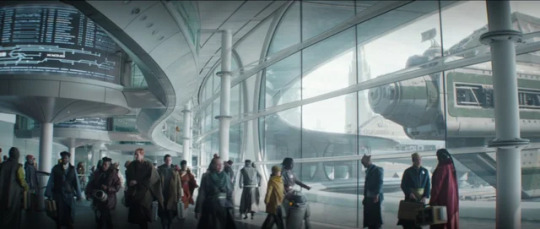
High Modernism is associated with the Cold War era of the late 1950s and 1960s-- and is therefore a DAMN good style choice for the ISB. My god. It's a design school that is all about technology and control: control over the environment, control over civic spaces, control over labor-- you name it.
The thing I associate with High Modernism above all else is the notion of state legibility: the idea that populations and spaces are organized into a structure that the state can read and therefore control. James C. Scott has a whole book about this, called Seeing Like a State. It's not my favorite of his works-- that would be Weapons of the Weak-- but his overriding thesis about how state policies of legibility are often destructive to culture and communities are worth coming back to. I mean, think about city and civil engineering, housing laws, city grids-- or Imperial sectors.
In our world, maybe the best example of High Modernism would be the work of Le Corbusier and his followers-- I mean, consider Brasilia! It's an artificially planned city, designed to reflect the aspirations of a growing nation: Ordem e Progresso, right? High Modernism tends to disregard historical realities, cultural practices, and the way people actually use spaces-- which, again, is exactly why Luke Hull is giving us this:

It's almost like these folks at ANDOR are good at their damn jobs, or something.
(Join me next time on SomeInstant Talks About Architecture in Andor: Wait, Is Niamos Space Acapulco, or What?)
#art and architecture#andor spoilers#andor#episode 4 spoilers#episode 7 spoilers#episode 6 spoilers#brutalism#art deco#high modernism#academic nonsense#sometimes i teach art history#production design#this is now a luke hull fanpage#star wars design#star wars#coruscant
193 notes
·
View notes
Text
Introducing: The Malevolent Tides
A Post-TLH Story - synopsis below!
Please note: The worldbuilding, TID, and TLH characters all belong to Cassandra Clare. I took the liberty to make up the children of the TLH characters (partially based off of the inaccurate Clockwork Princess family tree, but mostly from my own imagination). This story will contain spoilers for Chain of Thorns!
September, 1929: Coming of age during the mundane’s Great War and the Spanish Influenza, the young Shadowhunters of London are no strangers to demons and despair. In fact, compared to the hordes of demons attracted to Earth by the mundane conflicts of their youth, things have been relatively calm as the children grew from a troubled youth into a tentatively hopeful adolescence. Things are looking up… but little does this future “lost generation,” know, their light-hearted, wild youths are about to come to an abrupt end, as darkness and violence comes to claim the mundane - and shadow - worlds once again.
New York City, USA: Elizabeth Herondale has finally left her family’s home… and her drama with her brother, Owen, and his fiancée, Lydia, behind. Elizabeth is eager to forget her troubles in the vices that make New York City the center of the modern world; touted as a place where anyone can arrive a pauper and leave a millionaire, where women are free to move through the streets unaccompanied by men, and where illegal vices - booze, cards, jazz - are easier to find than avoid, Elizabeth is ready to relocate for good and reclaim her future. Accompanied by her intrepid parabatai and cousin, Margaret Blackthorn (who is more comfortable behind the lens of a camera than onstage in a flapper hall), Elizabeth has no plans to return to London any time soon. Then comes October, and the infamous crash of Wall Street that plunges the entire globe into economic recession. Elizabeth does not want to return home, but her and Margie might not have a choice in the matter…
Athens, Greece: Edmund Blackthorn was supposed to return to London and his family eight months ago… and he did, but something drew him back to Athens once more. Picking up his Uncle James’ love for the ancient classics from a young age, Edmund always knew he wanted to do his travel year in the center of it all: Athens, Greece. While he expected his year abroad to be full of research and sightseeing, he did not expect it to be entirely thrown off course by the witty, brilliant Cadia Sedgewick. Together, the two have uncovered an ancient mystery; while other Shadowhunters are urging them to focus on the rapidly-approaching and grim future, Edmund and Cadia are drawn further and further into the past. All the stories are true, after all, and this mystery might just be the key to aid the present and save the future.
Berlin, Germany: Owen Herondale didn’t plan to fall in love with Lydia Kingsmill… but Herondales love only once, as his father and grandfather told him from the time he was young, and Lydia was the only one for him. The Treaty of Versailles that ended the mundane Great War has thrust Germany into despair, and the Shadowhunters of the German institutes are feeling the side effects; indeed, as the churches and government are no longer able to tithe, many Shadowhunters have packed up and left for more lucrative cities, or returned home to Idris. Owen desperately wants Lydia to come to London with him, but Lydia doesn’t want to leave her family - and the institute she grew up in - behind.
Amsterdam, the Netherlands: Vienna Fairchild was determined to embark on a grand voyage like her father, and she wasn’t going to let the fact that she was a woman stop her. At the start of her travel year, Vienna ran to the last city full of glittering nightlife and wild parties in Europe - and indeed, Amsterdam is the last European stand of the ‘Roaring Twenties’ as recession grows over the continent like a shadow. Planning to pack her trunks and flee for the Americas with her best friends Lizzie and Margie, Vienna is stopped when the local institute desperately needs help. Their issue, however, is much larger than Amsterdam itself…
Alicante, Idris: The youngest of her siblings and cousins and friends, Alaina Blackthorn is thrilled to finally have her turn at Shadowhunter Academy. The Academy is, after all, a legendary place for life-changing bonds… it’s where her Uncle James and Uncle Matthew decided to become parabatai, and where her brother Theodore and Graham Fairchild first became friends - and now they, too, were parabatai. Flanked by her friends Raya Fairchild and Taron Carstairs-Lightwood, Alaina cannot wait to finally experience freedom - until the world starts to fall apart, and all their parents summon them back to London.
London, England: The adults of the London Enclave are certain the worst is behind them - they defeated Belial when they were teenagers, and the mundane world has finally calmed down after over a decade of war and pestilence. But the wicked never rest, and dark forces are gathering - and their target is London, the city that started it all.
#would people want to read it 🥹 let me know!!#there are SO many characters not in the synopsis#this is just a sneak peak hehe#but don’t worry all of our tlh faves have kids in this story!!#the last hours#tlh#the malevolent tides#james herondale#matthew fairchild#lucie herondale#cordelia carstairs#thomas lightwood#alastair carstairs#jesse blackthorn
80 notes
·
View notes